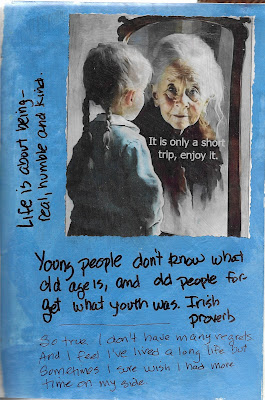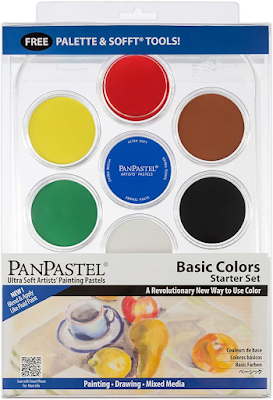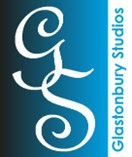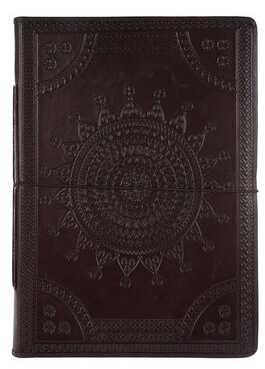Wow, what a hot summer this year. It seems
the only place that's cool is Barrow, Alaska (now referred to as Utqiagvik,
Alaska)at 64 degrees today. The most northern
city of the United State, Barrow isn’t where I’d want to spend my winters with
the average high of 3 degrees.
Even with the heat,
there's a lot of art to produce in the summer. One medium that’s always a bit dicey
in the winter is soft pastels. That’s because the dust can get all over the
place (including in your lungs), so it’s always best to work with it outdoors or at least, in a room with an opened window.
Drawing Pastels
Right now I’m working
on a flower piece from the magnolia tree in front of our house. What a lovely
flower and because it’s all white, it’s a bit hard.to capture the shadows.
As you can see above,
I’m just starting the project. I am using whites and greys but will add more
colors as I go along. White is very challenging because it not only has lots of
shadows, but it also picks up reflective colors. Hope I’ll do justice to this
piece. I’ll let you see the finished project as I go along.
For now, I’d like to
talk more about soft pastels. Last summer I covered oil pastels. So what is the
difference? While both can be used on pretty much the same paper (Mi-Tientes, sandpaper,
color pencil paper, thick drawing paper), the difference lies in how the pastel
sticks are made.
Oil pastels are made with pigment, oil and fillers. I do
enjoy working with them, especially in the winter, because they provide
immediate color, can be very smooth and present little danger to me.
Soft pastels on the other hand do
present a health risk as the little particles of dust can be inhaled, causing
some upper respiratory problems. If I had to choose between the two, however, I
will always opt for the soft pastel. I simply love them. The color goes down so
beautifully, the remaining effect on the paper is brilliant and, although messy
at times, are so much easier to clean up after.
Besides that, there are
pastel pencils and small hard pastel sticks that make your job so much easier
for those itsy-bitsy spots you must deal with. For example, although this is a
charcoal pencil drawing, you can see what I can execute with a small point,
i.e., the eyes on the lion.
The Products
Soft pastels come
usually in boxes. First off, I want to stress that you definitely get what you
pay for in soft pastels. Unlike oil pastels where you can purchase perhaps a cheaper
set like Pentel’s oil pastel and get somewhat of a good result, you cannot do
the same with the soft product. That’s because you will get far more filler
than pigment in the cheap stuff. Believe me, I’ve tried several products.
What to look for when buying soft pastels?
- Good color selection
- Strong pigment
- Soft, but not so soft, they crumble.
- Good reviews
So how does one start out? I found a product years ago that works for me. It's in the middle--not too cheap and not too expensive. The company's name is Mungyo. It's Korean and has been in business since 1946. Their products are good for starters. For instance, their 48 set is small and not too costly (around $7.50).
These pastels are NOT professional grade, but a cheaper way to see if you like them. I used to teach a class on pastel drawing. The morning half would consist of oil pastels and the afternoon would be soft pastels (with the good stuff). Often, students definitely liked one over the other. So it's important to try the product first before making too much of an investment.
I have gone up the ladder over the years and have bought their "gallery" pastels (around $25) . They are much better and again, good for starters.
Then there are the handmade soft pastels ($40) that Mungyo makes. Oh my goodness, they are fantastic, but of course spendy. I bought them this past year and I'm thoroughly enjoying them.
Hard Soft Pastel
I know the above sounds a bit oxymoron, but bear with me. There are two companies that offer soft pastels in hard stick form: Nupastel (by Prismacolor) and Conté à Paris Crayons. Again, in the early days when I was just starting out, I often used Nupastel.
They are great to start your drawing, fill in as a base coat and then cover over with more expensive/higher quality soft pastels. I also like them because sometimes, they are just perfect for filling in small places when I don't have my pastel pencils handy (around $12-$25).
Conté à Paris--both sets work well. I like the compact box version, easier to store in my bookcase.
Next Level: Rembrandt soft pastels
I used to work with Rembrandt exclusively for years until I was able to afford the more expensive pastels. They are harder (but not as much as NuPastel), but they still hold an important place in my pastel drawer (starting at around $40).
The Best: Sennelier
In my opinion, the best soft pastel on the market is made by Sennelier, a French company that's been around since 1887. I love the amount of pigment (lots), the softness of the stick and the way it thickly lays down on the paper. Starting at around $30. What I have done for years is look for sales on Amazon, Dick Blick, Jerry's Artarama. Occasionally they go on sale for a short period of time. Pictured below is a half stick set at $34 on Amazon.
When it comes to soft pastels, it does pay to shop around. In fact, I scour the Internet for deals for all my art supplies.
Pan Pastels
Recently, there has been a new product offered to pastel artists and that's
Pan Pastels. They offer a unique way of laying down your pastel colors. There are no sticks, but instead you use soft tools and layout your colors in a palette form.
I have a video on this one on my YouTube channel. To learn how to use this new product/method, please go to the following
link.
++++++++++++++++++++
Pastel Pencils
These pencils are great to use for small places or to create the perfect detail. But, they are difficult to keep sharpened. I have several sets and there isn't any one product that I have found that doesn't have a sharpening problem.
This problem is such a difficulty, you will see loads of videos on the Internet that try to help. There is one video, however, that I think does a pretty good job of explaining things. Here's the
link.
Okay, having given my warnings, here are the pastels pencils I use.
Austrian Cretacolor Art Pastels
Derwent Pastel Pencils
Paper
Last but not least, we need to talk about paper. I use Canson's Mi-Tientes paper. The same stuff I use for colored pencil. But I also have found that sanded paper is wonderful. Here are some suggestions:
Comes in lots of sizes and colors. Made in France. (Starting at $12)
Great texture, good color selection. Comes in six different color formats. Made in France. (around $30)
An outfit from Australia, Colourfix is a nice smooth sanded paper that comes in a lot of different colors. The one above is the cool packet . There are other packet colors to choose from. (starting around $30)
Conclusion
I have really only scratched the surface regarding soft pastel products. There are all sorts of color sticks and papers on the market today. I haven't tried all of them, but I can say that the ones I use are time-tested by me since 2006!
The art project
Here's the same flower from above but more complete. Just need to add more reflective colors and clean it up a bit. Done on Pastelmat, dark blue. BTW, this doesn't take long to complete--another advantage of soft pastel, quick and easy!
Happy Summer!
What happening this fall 2023



















































